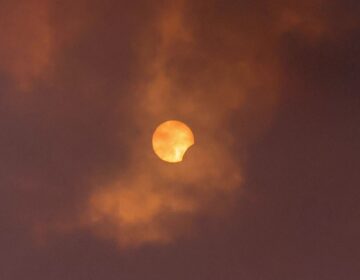Keeping Score
Listen 6:43
Saturn pulls ahead of Jupiter in the number of moons detected – current score: 82 to 79
Researchers recently announced the discovery of 20 new moons orbiting Saturn by using big telescopes at Hawaii’s Mauna Kea observatory equipped with very sensitive detectors. 17 of them orbit backwards, opposite the planet’s direction of rotation, and most of the new ones are about three miles in size.
The current idea about their origin is that they are the detritus left over from the breakup of a moon not long after Saturn’s formation billions of years ago.
When we think about all the energetic activity happening out there in the universe – supermassive black holes, millisecond pulsars, colliding neutron stars, exploding supernovae – it’s nice to know that in our little corner of the universe not much is happening, right?
Hold your horses, because maybe we’re just in between happenings.
Astronomers announced earlier this week that evidence has been detected that an enormous flare of ionizing radiation suddenly and explosively erupted from a source near the center of our galaxy. It was so powerful and extensive that evidence was found in gas stream 200,000 light years out in space!
Just as surprising as this discovery is, the researchers determined that it took place just 3.5 million years ago! The Chixulub impact that triggered the great dinosaur die-off occurred 62 million years earlier! Our ancestors were just going walk-about on the African continent when this explosion occurred.
So perhaps we’ve evolved in a relatively quiet period in the life of our galaxy. Remember, the evolution of the planet, solar system, galaxy and universe occurs over millions and billions of years and our studies only allow us to look at snapshots – instants in time which we try to assemble into a rational process that will allow us to reasonably predict what will happen in the future. BUT, we have a small number of ‘snapshots’ we’re trying to work with.
There are merely three days left to enter your idea for an exoplanet name
International Astronomical Union U.S. has an exoplanet and the IUA naming committee is asking the American public to submit their suggestions. You can do it all online and it’s a great short project for a school to jump on!
We’re running out of time to see Jupiter and Saturn in the evening sky.
The Franklin Institute’s Night Skies at the Observatory program this Tuesday night Oct. 15, will show Saturn telescopically for the last time this season.
WHYY is your source for fact-based, in-depth journalism and information. As a nonprofit organization, we rely on financial support from readers like you. Please give today.




